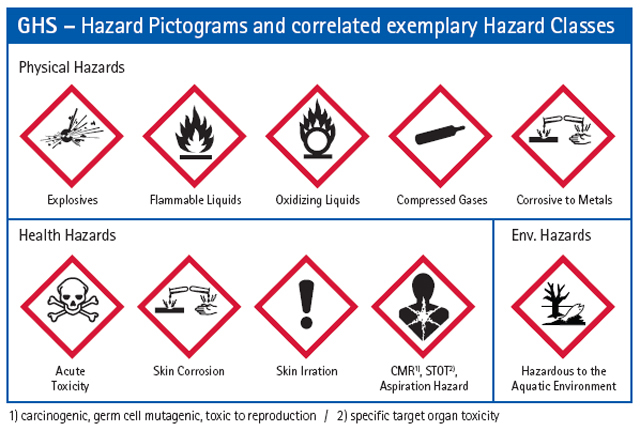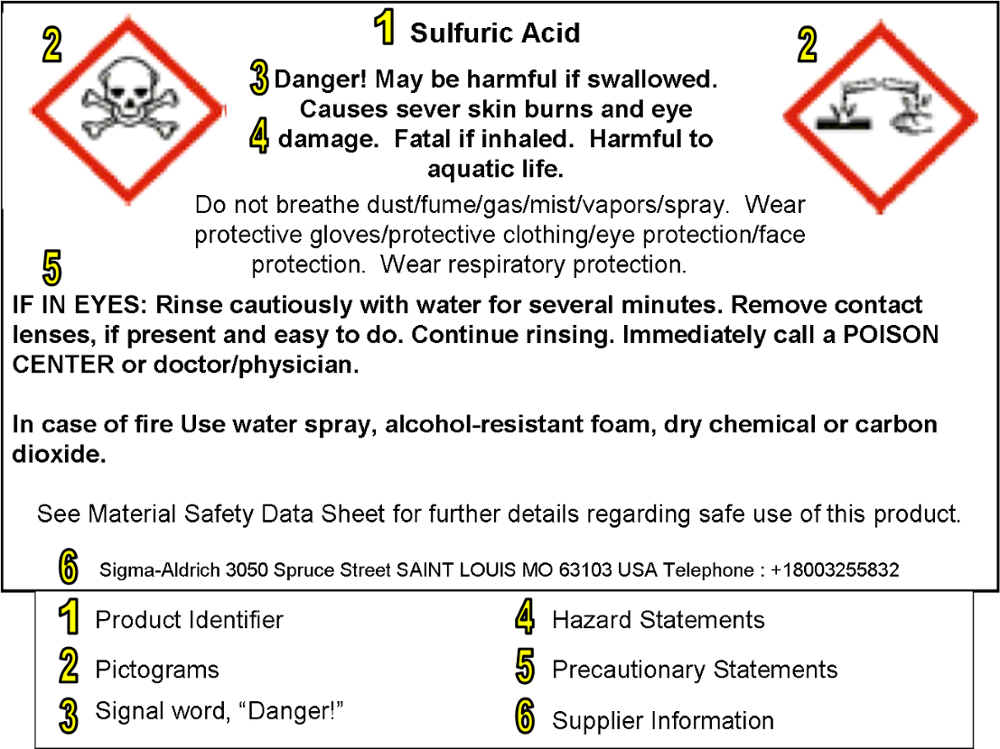Other hazards:
Examples of common hazards include the following
- Chemical hazards : Toxins, corrosives, flammables, and reactives
- Biological hazards : Microbes, animals, plants, and genetically modified agents
- Radiation hazards : Ionizing and nonionizing radiation
- Physical hazards : Heating devices, noise, fire, cold, etc.
- Electrical hazards : Fire and shock
- Mechanical hazards : Moving machinery
Other General Lab Hazards Video Illustration
Specific types of chemicals have been associated with harmful health effects. Common chemical hazards include:
- Skin irritation, disfiguring burns, eye injury or blindness caused by corrosive chemical products
- Toxic by-products, such as vapours and fumes, caused by mixing incompatible chemicals
- Serious burns from flammable solvents that catch on fire
- Injury from exploding containers, such as spray cans
- Poisoning from accidental ingestion
- Always read the label on the chemical bottle and SDS if using for first time.
- Always follow the directions and precautions listed on the label
- Never use a chemical if you are unsure what it is or how to protect yourself
- Always take the time to protect yourself and those working around you.
- Reduce or eliminate the use of hazardous chemicals whenever possible
- Maintain adequate ventilation systems to reduce concentrations of airborne chemicals.
- Practicing good personal hygiene maintaining regular workplace cleaning routines can reduce the amount of a chemical substance that is absorbed by a worker’s body.
- Use personal protective equipment and devices.
- Maintain equipment in good order to prevent leaks and breakdowns that may release toxic substances.
Biological agents are living things, or products of living things, that can cause illness and disease in humans. Biological agents include viruses, bacteria and fungi, as well as parasitic worms and some plants. Biological agents enter the body when they are inhaled, eaten (ingested) or absorbed. Most biological agents are inhaled. Once inside the body, these infectious agents can multiply quickly and may be passed from one person to another
Infectious agents are transmitted directly:
• through physical contact between an infected and non-infected person
• when droplets are projected, by a cough or a sneeze, into the mucous membranes of another person’s nose, eyes or mouth
• when a person is injected or punctured by an infected object, such as a needle
Other infectious agents are transmitted indirectly:
• by attaching themselves to food, water, cooking or eating utensils
• when an insect carries them from an infected to a non-infected person
• through the air, where they can be inhale
The best way to prevent illness is to reduce or eliminate exposure to biological agents. Some tips to protect yourself against infection:
• Practice good personal hygiene (e.g. regular hand washing) – it’s one of the best ways to prevent the transmission of infection.
• Keep your immunizations up-to-date.
• Ensure that any equipment that might harbour bio-hazards (e.g. fans, ventilation systems) is regularly maintained, cleaned and sterilized.
• Clean and disinfect work surfaces often.
• Clean up spills immediately.
• Handle and dispose of all bio-hazardous waste materials safely. Blood and any other bodily fluids should always be handled as if they could be infectious. In the event of an injury or bleeding, every individual should be handled in a way that minimizes exposure to blood and body fluids.
• Wear personal protective equipment (e.g. gloves, masks), where appropriate.
Ionizing and Non-ionizing Radiation may deposit energy in body, cause DNA damage, create ionizations in body leading to production of free radicals and biological damage.
Electrical hazards include electric shock, arc blasts, electrocutions, fires and explosions. Potential exposures to electrical hazards can result from faulty electrical equipment/instrumentation or wiring, damaged receptacles and connectors, or unsafe work practices.
- Use lead gloves, glasses and aprons when working with X-ray radiation emitting equipment. The lead shielding material in the gloves and aprons reduces the dose of scatter radiation well below 1/12th of the scatter radiation dose.
- Make sure workers display signs warning other persons that radiation-emitting equipment is in use
- Check the equipment periodically for possible leakage.
- Monitor yourself for contamination at frequent intervals when working with radioactive materials. Monitoring should include hands, body, shoes, and protective clothing.
- Confine work with gaseous/volatile radioactive materials, or processes which can create dust or aerosols to fume hoods or glove boxes, whichever is appropriate.
Label containers of radioactive material clearly, indicating radionuclide, activity, compound, date, and radiation level, if applicable.
- Always follow manufacturer’s recommendations for using electrical equipment.
- Do not use electrical equipment to perform a task for which it is not designed.
- Make sure that any outlet near a sink or other water source is Ground-Fault Circuit Interrupter (GFCI) protected. If you have a GFCI, periodically test it by plugging something into it and pushing the “test” button.
- Once the equipment shuts off just turn it back on. Above all, do not disable any electrical safety feature.
- Before turning equipment on, check that all power cords are in good condition. Do not use extension cords as a substitute for permanent wiring.
If you see a person being electrocuted, DO NOT TOUCH THEM! The electricity can go through you, too. If possible, turn off the power (pull the plug or trip the circuit breaker), or use an item made of non-conductive material (e.g., wooden broom handle) to pry him or her away from the contact. Call 911 immediately
- Fire hazards include electrical systems that are overloaded, resulting in hot wiring or connections, or failed components
- Combustibles near equipment that generates heat, flame, or sparks
- Candlesand other open flames
- Smoking (Cigarettes, cigars, pipes, lighters, etc.)
- Equipment that generates heat and utilizes combustible materials
- Flammable liquids and aerosols
- Flammable solvents placed in enclosed trash cans
- Electrical wiring in poor condition
- Personal ignition sources - matches, lighters
- Flammable liquids should be stored in Safety Storage Cabinets (yellow safety cabinets).
- Keep combustibles a safe distance from heat sources and stored at least 18 inches below the ceiling.
- Enforce "No Smoking" rules in applicable areas. Never use the trash can to extinguish smoking materials.
- Label all containers used for liquids with the name of the material and the words: "DANGER - FLAMMABLE (or COMBUSTIBLE)" - Keep away from heat, sparks, and open flames - Keep closed when not in use.
- When pouring liquids with a low flash point from a large (e.g. 5 gal.) can, ground the can to reduce development of static charge. This is particularly important in cold, dry weather.
- Cylinders containing flammable gases, such as hydrogen, acetylene, oxygen shall not be stored in close proximity to open flames, areas where electrical sparks are generated or where other sources of ignition may be present.


